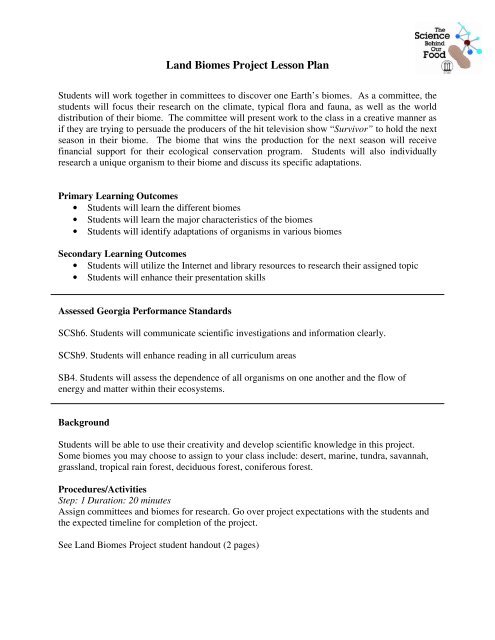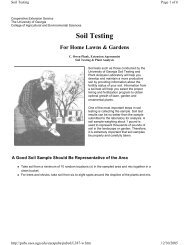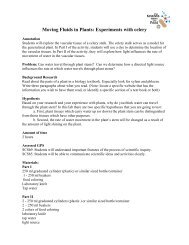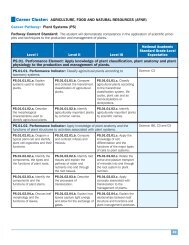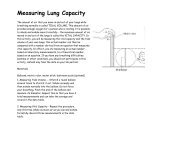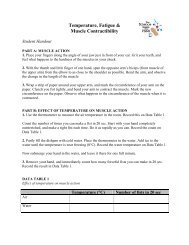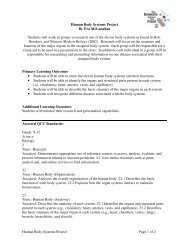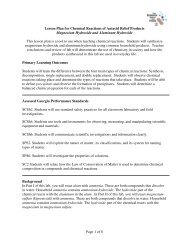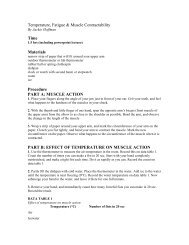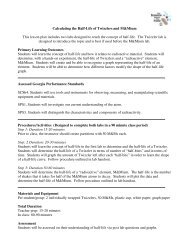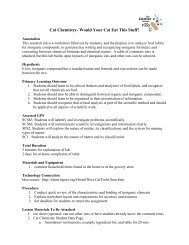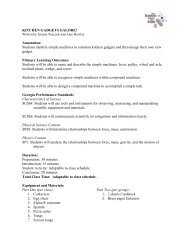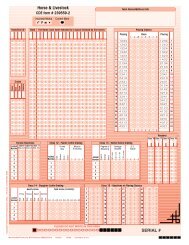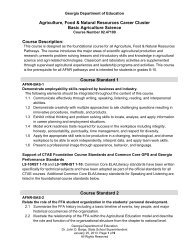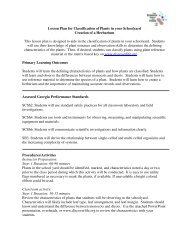Land Biomes Project Lesson Plan
Land Biomes Project Lesson Plan
Land Biomes Project Lesson Plan
Create successful ePaper yourself
Turn your PDF publications into a flip-book with our unique Google optimized e-Paper software.
<strong>Land</strong> <strong>Biomes</strong> <strong>Project</strong> <strong>Lesson</strong> <strong>Plan</strong><br />
Students will work together in committees to discover one Earth’s biomes. As a committee, the<br />
students will focus their research on the climate, typical flora and fauna, as well as the world<br />
distribution of their biome. The committee will present work to the class in a creative manner as<br />
if they are trying to persuade the producers of the hit television show “Survivor” to hold the next<br />
season in their biome. The biome that wins the production for the next season will receive<br />
financial support for their ecological conservation program. Students will also individually<br />
research a unique organism to their biome and discuss its specific adaptations.<br />
Primary Learning Outcomes<br />
• Students will learn the different biomes<br />
• Students will learn the major characteristics of the biomes<br />
• Students will identify adaptations of organisms in various biomes<br />
Secondary Learning Outcomes<br />
• Students will utilize the Internet and library resources to research their assigned topic<br />
• Students will enhance their presentation skills<br />
Assessed Georgia Performance Standards<br />
SCSh6. Students will communicate scientific investigations and information clearly.<br />
SCSh9. Students will enhance reading in all curriculum areas<br />
SB4. Students will assess the dependence of all organisms on one another and the flow of<br />
energy and matter within their ecosystems.<br />
Background<br />
Students will be able to use their creativity and develop scientific knowledge in this project.<br />
Some biomes you may choose to assign to your class include: desert, marine, tundra, savannah,<br />
grassland, tropical rain forest, deciduous forest, coniferous forest.<br />
Procedures/Activities<br />
Step: 1 Duration: 20 minutes<br />
Assign committees and biomes for research. Go over project expectations with the students and<br />
the expected timeline for completion of the project.<br />
See <strong>Land</strong> <strong>Biomes</strong> <strong>Project</strong> student handout (2 pages)
Step:2 Duration: 4-5 class periods<br />
You may choose to take students to the Media Center to perform research which will take more<br />
class time, but this also helps to watch and maintain the progress of the students.<br />
On the final day of the project plan to have group presentations, each about 10 minutes long.<br />
During the presentations, students should complete the <strong>Land</strong> <strong>Biomes</strong> Summary Sheet as well as<br />
the Organisms and Their Adaptations. This provides all students in the class with a summary of<br />
the biomes and a study guide for the test.<br />
See <strong>Land</strong> <strong>Biomes</strong> Summary Sheet student handout (2 pages) and Organisms and Their<br />
Adaptations student handout (2 pages).<br />
The instructor should evaluate the groups based on their presentation content and skills as shown<br />
in the Rubric on the last page of this document.<br />
Materials and Equipment<br />
Teacher may choose to provide materials for the presentations (i.e. posterboard, blank white<br />
paper, colored pencils, markers, rulers, etc.)<br />
Access to technology and the media center resources (encyclopedias, books, etc.) is useful if this<br />
is to be completed as an in-class project.<br />
Total Duration<br />
1 week class time (60 or 90 minute periods)<br />
Students may have to complete some work outside of class<br />
Assessment<br />
Students are assessed as a group on their presentation and flyer for the biome. Students are<br />
assessed individually based on their flyer for their organism and their completion of the summary<br />
sheets.
<strong>Land</strong> <strong>Biomes</strong> <strong>Project</strong><br />
Due: __________________________<br />
Biome: _________________________<br />
Committee Members: ___________________________________________________________<br />
INTRODUCTION<br />
As a committed conservationist, you are concerned about the state of your biome. To ensure the survival of your biome,<br />
you need to acquire money for your conservation projects. Since your biome is the best place in the world, you have decided that<br />
perhaps you could make some money by hosting “Survivor” in your biome. If the television show is produced in your biome,<br />
your ecological conservation program will receive financial benefits.<br />
TASKS<br />
Your objective is to convince the producers of “Survivor” that your biome should be chosen for the show. Your task will consist<br />
of several parts. You and your committee are assigned the following responsibilities:<br />
1. Produce a flyer describing your biome (e.g. average temperature & precipitation), outlining what ecological concerns in<br />
your biome merit funding<br />
2. Individually produce a flyer on an organism in your biome & its adaptations<br />
3. Design a reward challenge unique to your biome<br />
4. Make a presentation to the producers of the “Survivor” series<br />
5. Evaluate the suitability of each biome for “Survivor”<br />
Guidelines set by the producers of “Survivor” are as follows:<br />
There will be 4-5 committee members.<br />
The flyer will contain the following information –<br />
name of the biome<br />
world distribution of the biome (you may include a map)<br />
location within the biome you want “Survivor” to be filmed (i.e. city, island, etc.)<br />
climate of the biome (i.e. average temperature & precipitation)<br />
typical flora (plants)<br />
typical fauna (animals)<br />
ecological concerns, current & future conservation efforts<br />
visuals (pictures, diagrams) to enhance the appeal of the flyer<br />
Each committee member will choose one plant or animal that lives in their biome and make a separate flyer that<br />
describes the organism and its adaptations. Pictures should be included if at all possible.<br />
As a committee, design a reward challenge unique to your biome. (Look at the Survivor web site,<br />
http://www.cbs.com/primetime/survivor, for an outline of some of the past reward challenges – click on “show”, then<br />
“challenges”.) Your reward challenge must be presented on a poster using the following format:<br />
Picture of<br />
challenge<br />
Challenge Name<br />
Challenge Location<br />
***A complete bibliography for the<br />
entire project should be attached<br />
to the back of the poster.***<br />
Reward<br />
Description<br />
NOTE: Description of Challenge<br />
should be approximately 5<br />
sentences.<br />
PRESENTATION:<br />
Each committee has approximately 10-15 minutes to make their presentation (description of biome, individual organism<br />
& adaptations, reward challenge)<br />
All members must speak.
EVALUATION:<br />
All committees, when not making presentations, are acting members of the “Survivor” production team and are<br />
responsible for completing the summary sheet on the biomes and the organism and adaptation summary.<br />
Grading: (project)<br />
Research info sheet: (individual) 5 points<br />
Biome flyer: (group) 25 points<br />
Organism flyer: (individual) 25 points<br />
Reward challenge: (group) 20 points<br />
Complete bibliography: (group) 10 points<br />
Complete summary sheets: (individual) 15 points<br />
100 points total<br />
Grading: (presentation)<br />
Group (biome, reward challenge) 50 points<br />
Individual (organism & adaptations) 50 points<br />
RESOURCES:<br />
100 points total<br />
Books & Encyclopedias: The Media Center has a large collection of books and science encyclopedias that you may find<br />
helpful. There is a set of encyclopedias on biomes.<br />
Online Resources: Be sure to establish the authority of any site that you visit.<br />
• General search: Search “biomes” or your assigned biome in Yahoo or Google.<br />
• http://www.blueplanetbiomes.org/world_biomes.htm<br />
• http://www.runet.edu/~swoodwar/CLASSES/GEOG235/biomes/main.html<br />
• http://www.cotf.edu/ete/modules/msese/earthsysflr/biomes.html<br />
• http://www.ucmp.berkeley.edu/glossary/gloss5/biome/index.html<br />
• http://earthobservatory.nasa.gov/Laboratory/Biome/
Name _________________________________<br />
LAND BIOMES SUMMARY SHEET<br />
Biome<br />
World<br />
Distribution<br />
Average<br />
Temperature<br />
Average<br />
Precipitation<br />
Typical Flora Typical Fauna Ecological<br />
Concerns<br />
Conservation<br />
Efforts
Biome<br />
World<br />
Distribution<br />
Average<br />
Temperature<br />
Average<br />
Precipitation<br />
Typical Flora Typical Fauna Ecological<br />
Concerns<br />
Conservation<br />
Efforts<br />
Questions:<br />
Which biome do you think has the greatest ecological concerns? Why?<br />
Which biome do you think is the most challenging for humans to live in? Why?
Name________________________________________<br />
LAND BIOMES PROJECT: Organisms & Their Adaptations<br />
Organism Biome/habitat Adaptations Interesting fact(s)
Organism Biome/habitat Adaptations Interesting fact(s)
Name _____________________________________<br />
LAND BIOMES PROJECT<br />
Research Information Sheet<br />
Biome: ____________________________________<br />
Committee Members: ____________________________________________________________________<br />
Biome:<br />
World Distribution<br />
Location of filming<br />
Average temperature<br />
Average precipitation<br />
Typical flora (plants)<br />
Typical fauna (animals)<br />
Ecological concerns<br />
Current conservation efforts<br />
Future conservation efforts
Organism: ______________________________________________________________________<br />
General physical description<br />
Habitat description<br />
Distribution (world or within biome)<br />
Adaptations<br />
Interesting fact(s)
BIBLIOGRAPHY<br />
NOTE: You must list all resources you use. Also, do not plagiarize – it is a crime.
LAND BIOMES PROJECT PRESENTATION RUBRIC<br />
Biome _________________________ Members __________________________________________________<br />
EXCELLENT<br />
(4)<br />
GOOD<br />
(3)<br />
FAIR<br />
(2)<br />
POOR<br />
(1)<br />
CONTENT<br />
______<br />
All required<br />
information is<br />
presented.<br />
Most of the required<br />
information is<br />
presented.<br />
Some of the<br />
required<br />
information is<br />
presented.<br />
Hardly any required<br />
information is<br />
presented.<br />
ORGANIZATION<br />
______<br />
EYE CONTACT<br />
______<br />
VISUAL AID<br />
______<br />
Presentation is well<br />
organized and easy<br />
to follow.<br />
Transition between<br />
topics is smooth.<br />
Eye contact is made<br />
throughout the<br />
entire presentation.<br />
No part of the<br />
presentation is read.<br />
Visual aid is<br />
creative, colorful,<br />
easy to read, and<br />
used effectively.<br />
Presentation is<br />
organized and easy<br />
to follow but<br />
transition between<br />
topics is not smooth.<br />
Eye contact is made<br />
throughout most of<br />
the presentation.<br />
Some of the<br />
presentation is read.<br />
Visual aid is<br />
colorful, readable<br />
and used somewhat<br />
effectively.<br />
Presentation is<br />
somewhat organized<br />
but hard to follow.<br />
Eye contact is made<br />
only during some of<br />
the presentation.<br />
Most of the<br />
presentation is read.<br />
Visual aid is lacking<br />
color, difficult to<br />
read, and not used<br />
effectively.<br />
Presentation is very<br />
unorganized and<br />
difficult to follow.<br />
No eye contact is<br />
made throughout the<br />
entire presentation<br />
and all of it is read.<br />
Visual aid is not<br />
used at all in the<br />
presentation.<br />
VOICE<br />
______<br />
Presentation is loud<br />
and given at a slow<br />
pace that’s easy to<br />
follow.<br />
Presentation is<br />
audible and given at<br />
a good pace.<br />
Presentation is<br />
barely audible and<br />
given at a fast pace.<br />
Presentation is<br />
inaudible and given<br />
at a pace too fast to<br />
follow.<br />
TOTAL POINTS = _____________ X 2.5 = ______________<br />
COMMENTS:


